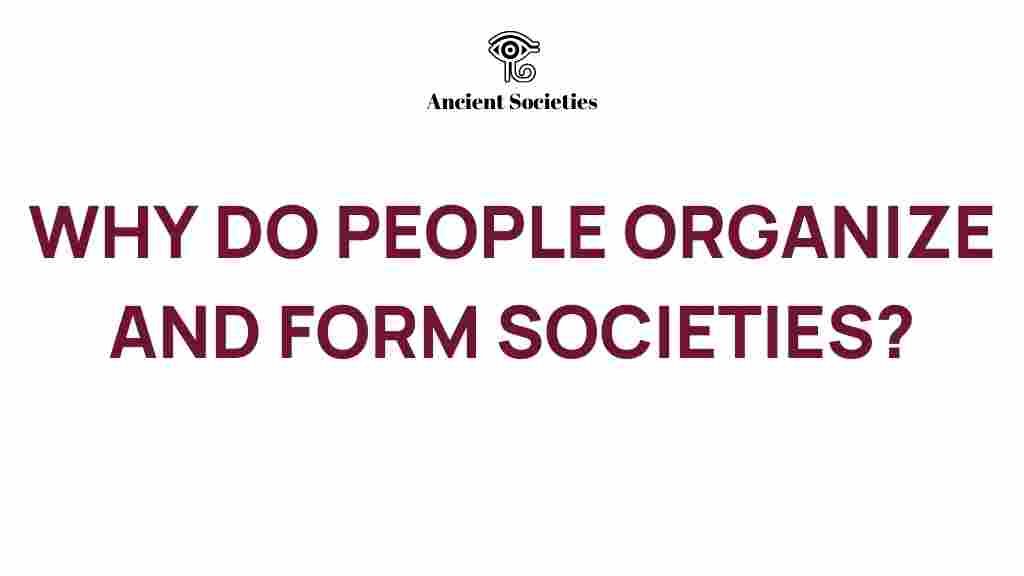Unraveling the Enigma: Why Do People Form Societies?
The formation of societies is a fundamental aspect of human behavior. Throughout history, humans have come together to create social structures that fulfill their needs and aspirations. But what drives this innate tendency to form communities? In this article, we will explore the various factors that contribute to the establishment of societies, examining concepts from anthropology, culture, and social dynamics.
The Foundation of Societies
At the core of human existence lies the need for connection. Societies provide a framework for individuals to engage with one another, share resources, and build a sense of belonging. The following factors are crucial in understanding why people form societies:
- Survival Needs: Early human societies formed primarily out of necessity. Hunting, gathering, and later agriculture required collaboration and organization.
- Safety and Security: In groups, individuals found protection from predators and other threats. A collective approach ensured greater security.
- Resource Management: Societies developed to manage natural resources efficiently, ensuring sustainability and equitable distribution.
- Cultural Exchange: The interaction between different groups led to the sharing of ideas, customs, and innovations, enriching the cultural landscape.
- Social Identity: Being part of a society provides individuals with a sense of identity and belonging, crucial for psychological well-being.
The Role of Culture in Societal Formation
Culture is a significant driver in the formation of societies. It encompasses the beliefs, values, practices, and artifacts that characterize a group. Cultural elements shape how societies function and how individuals relate to one another. Here are some cultural aspects that influence human behavior within societies:
- Language: A common language fosters communication, allowing for the sharing of knowledge and traditions.
- Religion: Shared beliefs and practices can unify individuals, creating strong social bonds and communal identity.
- Traditions and Customs: Rituals and social norms guide behavior and reinforce societal values.
- Art and Expression: Artistic endeavors reflect cultural values and serve as a means of communication and connection.
Social Structures and Their Importance
Social structures are the organized patterns of relationships and social arrangements that shape society. They play a critical role in how we interact and function within our communities. Key components of social structures include:
- Institutions: Schools, governments, and religious organizations provide frameworks for social interaction and governance.
- Roles and Norms: Each member of society has specific roles that dictate behavior and expectations, contributing to social order.
- Social Hierarchy: Class and status can influence access to resources and power within a society.
The Evolution of Societies Throughout History
Understanding the historical context of societal formation can provide insights into human behavior. Societies have evolved significantly over time, influenced by various factors:
- Economic Changes: The transition from hunter-gatherer societies to agricultural and industrial societies transformed social structures.
- Technological Advances: Innovations have reshaped communication, transportation, and the dissemination of information, altering how societies function.
- Political Developments: The rise and fall of empires, the establishment of governments, and the emergence of democracy have influenced social dynamics.
Social Dynamics: The Interplay of Individual and Society
Social dynamics refers to the behaviors and interactions that occur within a society. This interplay is crucial in understanding how societies function and evolve. Key aspects include:
- Group Behavior: Individuals often behave differently in groups than when alone, influenced by peer pressure and social norms.
- Conflict and Cooperation: Societies are often marked by tensions, but cooperation can lead to resolution and progress.
- Change and Stability: Societies are dynamic; they can change rapidly due to external pressures or evolve slowly over time.
Step-by-Step Process: How Societies Form
The formation of societies can be viewed as a step-by-step process. Here’s a simplified breakdown:
- Gathering of Individuals: People come together based on shared interests or needs.
- Establishment of Communication: Language and symbols are developed to facilitate interaction.
- Creation of Norms and Values: Societal norms emerge to guide behavior and promote cohesion.
- Development of Institutions: Organizations are formed to manage resources and provide structure.
- Formation of Governance: Leadership roles and systems are established to create order and resolve conflicts.
- Continuous Evolution: Societies adapt to changes in environment, technology, and culture.
Troubleshooting Tips: Challenges in Societal Formation
While forming societies can lead to many benefits, challenges often arise. Here are some common issues and how to address them:
- Conflict Resolution: Encourage open communication and mediation to resolve disputes and maintain harmony.
- Resource Scarcity: Implement sustainable practices and equitable distribution to ensure all members have access to essential resources.
- Cultural Disparities: Promote inclusivity and understanding through education and dialogue about different cultures.
- Social Inequality: Address systemic issues by fostering policies that promote equal opportunities for all individuals.
For more information on social structures and their impact on communities, check out this Sociology Guide.
Conclusion
In conclusion, the formation of societies is a complex interplay of human behavior, culture, and social dynamics. Understanding why people come together in organized communities reveals much about our nature and history. Societies provide a necessary framework for survival, identity, and cultural exchange, adapting over time to meet the needs of their members. As we continue to navigate the complexities of modern life, recognizing the importance of these social structures can help us build more inclusive and resilient communities.
For a deeper exploration of societal structures and their histories, consider reading more about anthropology and its role in understanding human behavior. You can find additional resources here.
This article is in the category Society and created by AncientSocieties Team
